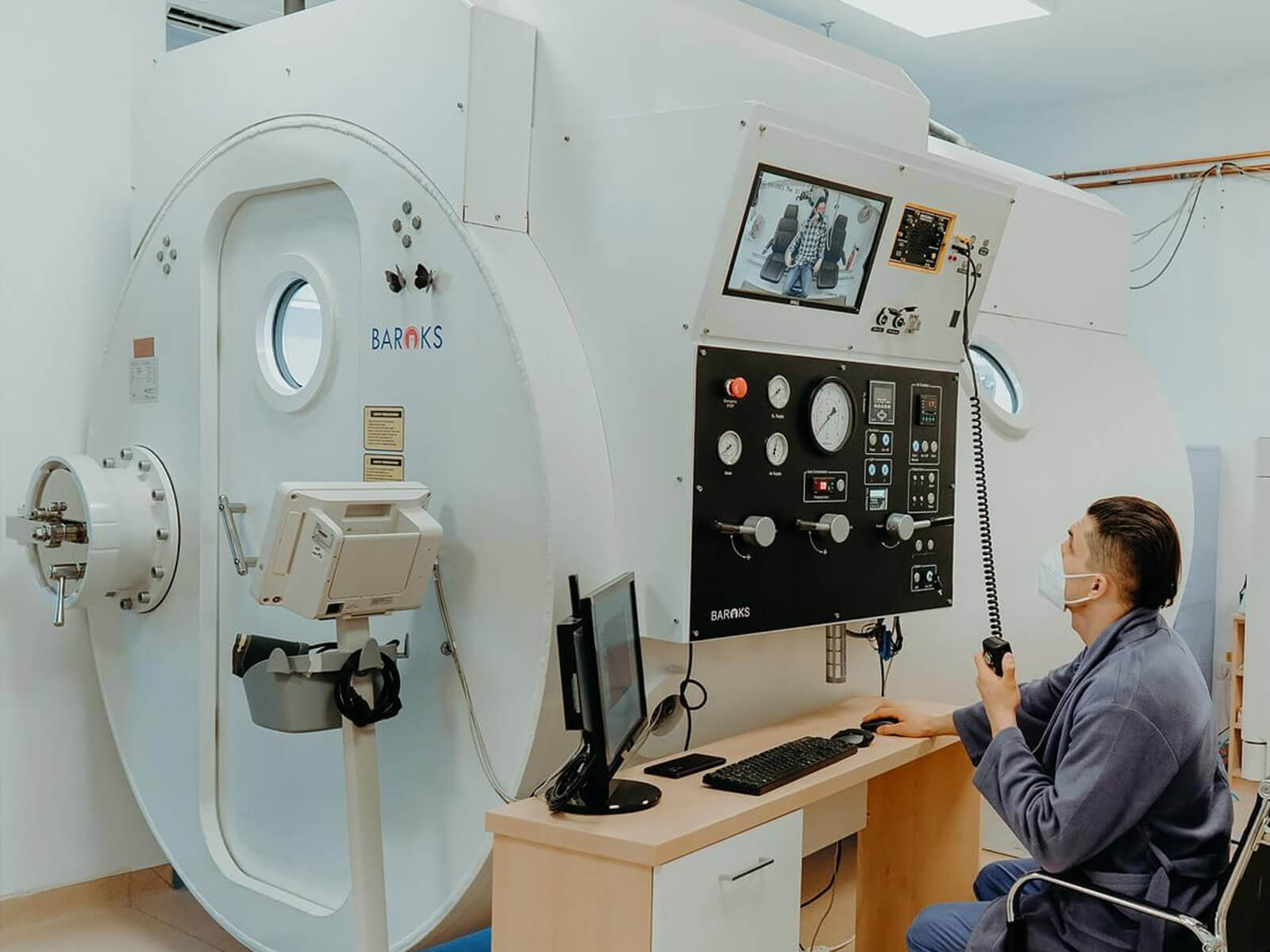
Hyperbaric oxygen
How does hyperbaric oxygen work
Hyperbaric medicine is effective for a multitude of disorders, as it determines the following basic actions:
- additional oxygenation of the body through the diffusion of oxygen into the blood plasma and subsequently into all the fluids of the body, increasing up to 6 times the availability of O2 for tissues (table 1)
- increases the antimicrobial capacity of the body to fight infections
- stimulates the creation of new capillaries
- increases anti-inflammatory tissue perfusion
- improves the overall metabolic level
- stimulates the production of red blood cells
- stimulates the production of stem cells (up to 400% after 40 sessions)
- reduces edema
- increases the rate of healing in chronic lesions (e.g. skin ulcers)
A person exposed to hyperbaric oxygen therapy has up to 20 times oxygen dissolved in arterial blood, and other biological fluids, such as the cerebrospinal fluid, are also perfused with additional oxygen. Hemoglobin is not additionally loaded, as it already is at maximum capacity (arterial blood, 9599% Hb saturation). Oxygen diffuses from the capillaries into the tissues and reaches the weakly perfused or non-perfused areas. According to the Kogh diffusion coefficient, more oxygen is supplied to the tissues through diffusion than through the bloodstream.
The overall effect is that of hyperoxygenation of the body, therefore the process is called hyperbaric oxygen therapy.
Hyperbaric oxygen therapy session
The treatment may be carried out in an enclosure for one or more patients. Our clinic uses a multi-place one for 6 people, as well as a single-place hyperbaric chamber. Pressurization is achieved by atmospheric air, and the patient breathes O2, administered through a comfortable mask and a breathing system with adequate flow to the current respiratory volume (BIBS-build in breathing system) which will ensure a relaxed posture during therapy. At the beginning of the therapy, there is a pressurizing noise of the air entering the chamber. During the treatment and particularly in the first minutes, the ears may be clogged, similar to the sensation when the plane takes off, and gentle maneuvers are required, to balance the pressure between the middle and outer ear, through rotational mandibular movements, by yawning, swallowing, by applying the Valsalva maneuver. The doctor will assist the patient throughout the treatment. Towards the end of the treatment, the pressure in the hyperbaric chamber starts decreasing, slightly returning to the normal one.
An example of therapy is shown in Fig. 1. Table 9 is used by the U.S. Navy, as it is one of the most used therapies alongside other specific decompression maneuvers. During this treatment, the patient initially breathes atmospheric air as the pressure in the room increases accordingly at a rate of about 2 meters of sea water (msw) per minute. The therapeutic range of 13.5 -20 msw is reached, after which the patient breathes 100% oxygen in the first 30-minute step. There is an air break of 5 minutes, followed by treatment with the second stage of 30 minutes of oxygen. Finally, the "surface lift" - decompression, is performed, also at a rate of 2 msw/min. This treatment may be adjusted as duration and as maximum pressure level depending on the clinical condition and on the prevailing condition.
Therapy has 3 stages: a) compression, which lasts for approximately 15 minutes, b) the actual treatment session, with the duration calculated according to the treatment, c) decompression, with the same duration as the compression.
Depending on the diagnosis, a type of treatment will be chosen with a pressurization level (depth of immersion) between 2 and 3 ATA (absolute atmosphere - atm + ordinary atmosphere) and rigorously calculated exposure times maintained during therapy (1, 2, 3 hours).
During the session with hyperbaric oxygen, the air pressure in the room reaches a value of two, up to three times, higher than normal. This increase in pressure will cause a temporary sensation of ear clogging, similar to that felt during a plane take-off or when reaching high altitudes. This sensation may be reduced by yawning or swallowing. In order for the effects of oxygen therapy to settle, the patient will most likely undergo several treatment sessions. The number of sessions depends on the patient's medical condition. For certain conditions, such as carbon monoxide poisoning, three treatment sessions are required. Other conditions, such as wounds that are difficult to heal, require 10 to 20 treatment sessions. As regards neurological disorders, for a partial/total recovery, between 20 and 40 consecutive sessions are required, 1-2 per day, 5-6 days per week, depending on the condition of each patient.
Hyperbaric oxygen therapy is extremely effective and therefore recommended as a unique treatment for decompression disease, arterial embolism and severe carbon monoxide poisoning.
To enhance the efficiency of treating other conditions, hyperbaric oxygen therapy can be part of a comprehensive treatment plan and may therefore be administered jointly with other therapies and medicines.

Hyperbaric oxygen therapy implies the inhaling of pure oxygen in a pressurized chamber or cabin. In addition to the applications in the decompression sickness of divers, hyperbaric oxygen therapy is also a treatment for other conditions such as serious infections, wounds that are difficult to heal, complications of diabetes or radiotherapy.
In a hyperbaric oxygen therapy chamber, the air pressure is increased until it reaches values that are three times higher than those of normal air pressure. In these conditions, more pure oxygen is concentrated in the lungs, compared to the oxygen level at normal air pressure values.
This increased amount of oxygen is carried through the blood vessels in the entire body. The increased concentration of systemic oxygen helps the body fight bacteria and at the same time stimulates the synthesis and release of growth factors and stem cells, which promotes tissue regeneration and healing.
Recommendations
Summary of international indications for HBOT:
- Recovery in spastic hemiplegia after stroke, paraplegia
- Myocardial insufficiency, peripheral vascular disease
- Embolism
- Asphyxiation: drowning, smoke inhalation, etc.
- Cardiovascular diseases and post cardiac surgery
- Decompression sickness
- Dentistry: refractory periodontitis, adjuvant implant therapy
- Endocrine: diabetes, diabetic foot
- Radiotherapy
- Gastrointestinal: gastric ulcer, necrotizing enterocolitis, paralytic ileus, hepatitis
- Head and neck surgery: osteoradionecrosis and osteomyelitis of the jaws
- Hematology: severe anemia
- Pulmonary diseases: pulmonary abscess, pulmonary embolism (adjuvant to surgery)
- Neurological: stroke, multiple sclerosis, migraine, cerebral edema, multi-infarct dementia, spinal-cord injury and vascular diseases of the spinal cord, brain abscess, peripheral neuropathy, radiation myelitis, vegetative coma
- Obstetrics: complicated pregnancy - diabetes, eclampsia, heart diseases, placental hypoxia, fetal hypoxia, congenital heart disease of the newborn
- Ophthalmology: central retinal artery occlusion
- Orthopedics: non-unification of fractures, bone grafts, osteoradionecrosis
- Otolaryngology: sudden deafness, acute acoustic trauma, labyrinthitis, Meniere's disease, malignant otitis externa (chronic infection)
- Peripheral vascular disease: ischemic gangrene, critical limb ischemia
- Plastic and reconstructive surgery: for the healing of wounds that do not heal
- survival of cutaneous flows with marginal circulation, as an aid in reimplantation surgery and as an aid in the treatment of burns
- Poisoning: carbon monoxide, cyanide, etc.
- Traumatology: crushing injuries, compartment syndrome, etc.
- Treatment of certain infections: gangrene, acute necrotizing fasciitis, refractory mycosis, osteomyelitis
Those who advocate for the use of hyperbaric oxygen point out that the increased pressure and supplemental oxygen can stimulate various bodily functions. Numerous studies support the administration of this form of treatment in conditions such as encephalopathies, tinnitus and sensorineural hearing loss, atherosclerosis, necrotizing fasciitis, various brain injuries, multiple sclerosis, fractures, acute ischemia, vascular dementia, ulcerative colitis, osteomyelitis, proctitis (rectitis), burns, various forms of cancer, and more. An increasing number of clinical trial results indicate the effectiveness of hyperbaric chamber therapy in the alternative treatment of autism, attention deficit hyperactivity disorder (ADHD), and post-traumatic stress disorder (PTSD).
Regarding the treatment of brain injuries, clinical research results show that hyperbaric oxygen activates brain healing processes by stimulating the function of dormant neurons and enhancing axonal growth.
As for specific cerebral vascular conditions, in Japan, patients who suffer from strokes or other acute neurological conditions are commonly treated with hyperbaric chambers.
Adverse Effects
Hyperbaric oxygen therapy is considered a safe form of treatment with rare complications. The side effects, if they occur, are generally mild when the treatment duration does not exceed two hours, and the pressure inside the chamber is less than 3.5 ATA. What is Barotrauma?
What is Barotrauma?
The primary reported side effect of hyperbaric oxygen treatment is barotrauma. This condition is characterized by discomfort or pain experienced when there is a difference in pressure between the two sides of the eardrum. The discomfort or pain is similar to what one might feel during an airplane's takeoff. To date, no hyperbaric chamber treatment has caused eardrum ruptures.
Bibliography
- Textbook of Hyperbaric Medicine, Kewal K. Jain, Springer International Publishing AG 2017, 6th Edition, ISBN 978-3-319-47138-9 ISBN 978-3-319-47140-2 (eBook), DOI 10.1007/978-3-319-47140-2
- Hyperbaric Oxygen Therapy Indications, 13th edition, Lindell K. Weaver, Best Publishing Company, FL, ISBN 978-1930536-73-9, 2014
- Physiology and Medicine Of Hyperbaric Oxygen Therapy, Tom S. Neuman, ISBN 978-1-4160-3406-3, 2008
- Handbook on Hyperbaric Medicine, Daniel Mathieu, Springer, ISBN-13 978-1-4020-4376-5, 2006
- Mader JT, Adams KR, Couch LA, et al. Potentiation of tobramycin by hyperbaric oxygen in experimental Pseudomonas aeruginosa osteomyelitis (Abstract 1331). Abstracts of the 27th Interscience Conference on Antimicrobial Agents and Chemotherapy. Washington, DC, American Society for Microbiology 1987.
- Hunt TK. The physiology of wound healing. Ann Emerg Med 1988; 17:1265–73.
- Knighton DR, Silver IA, Hunt TK. Regulation of wound-healing angiogenesis—effect of oxygen gradients and inspired oxygen concentration. Surgery 1981; 90:262–70.
- Weiss SJ. Tissue destruction by neutrophils. N Engl J Med 1989; 320:365–76.
- Myers RAM. Hyperbaric oxygen therapy for trauma: crush injury, compartment syndrome, and other acute traumatic peripheral ischaemias. Int Anesthesiol Clin 2000; 38:139–51.
- Zamboni WA, Roth AC, Russell RC, Graham B, Suchy H, Kucan JO. Morphological analysis of the microcirculation during reperfusion of ischaemic skeletal muscle and the effect of hyperbaric oxygen. Plastic Reconstr Surg 1993; 91:1110–23.
- Thom SR. Antagonism of carbon monoxide-mediated brain lipid peroxidation by hyperbaric oxygen. Toxicol Appl Pharmacol 1990; 105:340–4.
- Villanucci S, Di Marzio GE, Scholl M, et al. Cardiovascular changes induced by hyperbaric oxygen therapy. Undersea Biomed Res 1990; 17 (Suppl. 1):117.
- Wattel F, Mathieu D, Neviere R, Bocquillon N. Hyperbaric therapy: acute peripheral ischaemia and compartment syndrome: a role for hyperbaric oxygenation. Anaesthesia 1998;53(Suppl. 2):63–5.
How can you become a patient of our clinic?
Throughout the whole process, from your initial contact, through treatment and after you leave our clinic, our patient coordinators will guide you through the steps and support you with all their expertise, attention and kindness.
*
We are here to help you
Our patient coordinator will contact you soon
Phone: +40.771.518.946, e-mail: office@imuno-medica.ro




